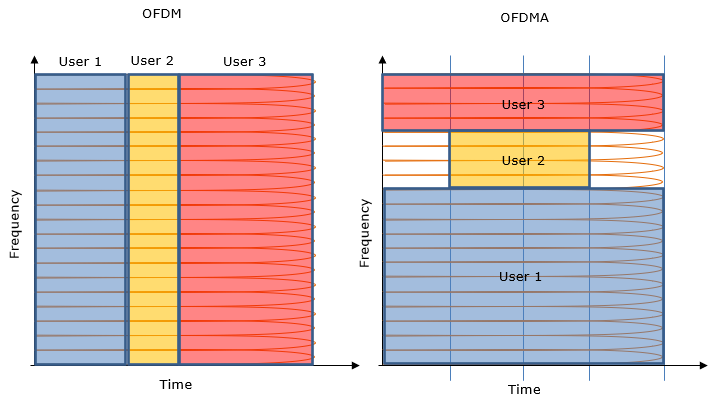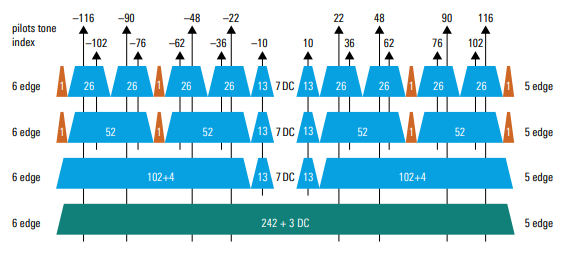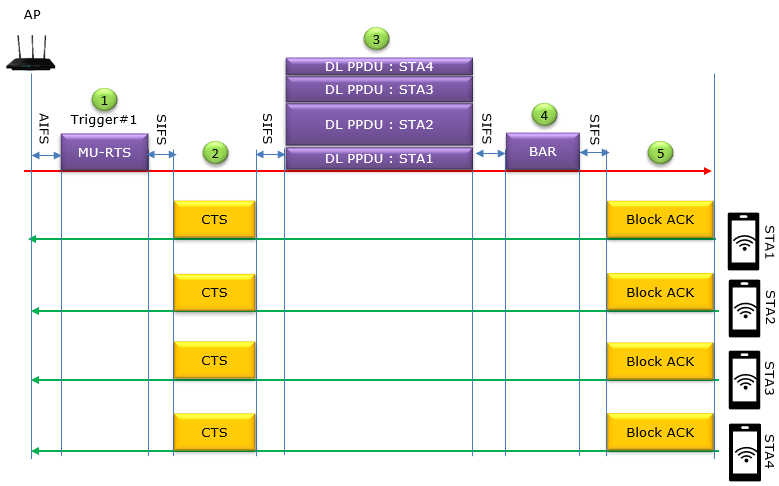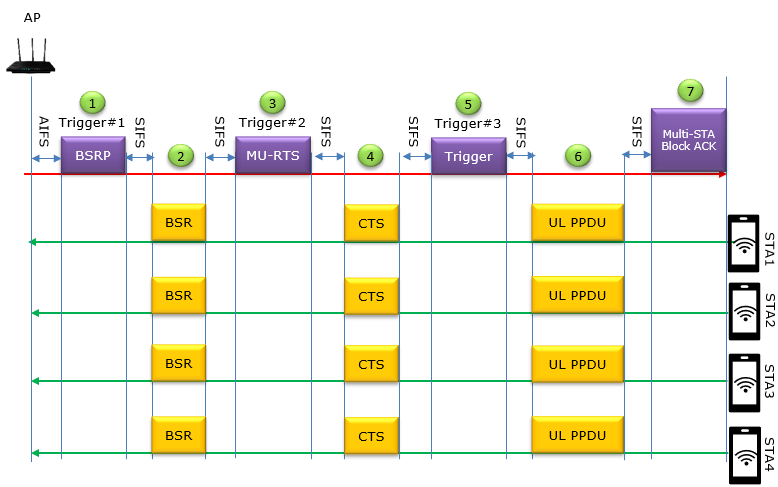|
|
||
|
OFDMAOFDMA (Orthogonal Frequency Division Multiple Access) is a new technology introduced from 802.11ax (WiFi 6). It is a technology that enable an WiFi AP to communicate with multiple STA(User) at the same time. The main difference between OFDM and OFDMA can be illustrated as follows. In OFDM, at a given time ONLY ONE user take up the full frequency spectrum. On the contrary, in OFDMA at a given time MULTIPLE user can split the full spectrum into multiple frequency segments and communicate SIMULTANEOUSLY with AP. In this scheme, each user using the different frequency spectrum the signal from each of the user does not collide each other (i.e, no problem with CSMA/CA process).
What is the problem with the existing method (OFDM) ?Why we decided to introduce the OFDMA in WiFi ? In other words, is there any problem with the exising method (OFDM) ? I wouldn't say there is any problem with OFDM but I can say there is some inefficiency with it. The enefficiency come from the fact that at a given time a SINGLE user takes up the full spectrum and no other user can communicate during the period. This would cause inefficiency in two important aspects. First thing is that this type of spectrum allocation would cause waste of resource in many case. A report shows that considerable amount of WiFi traffic is only the size of 256 Byte or less and it would be obvious that such a small amount of traffic would require the full spectrum. Another issue is that it would not allow multiple user (i.e, more than one user) to communicate simultaneously at a given time, meaning that all other User should wait until the one user finish its traffic. This would cause time delay for all the user except the one user. OFDMA solves the issues mentioned above. OFDMA can split the full spectrum into multiple segments that are just enough for each user leading to more efficient use of spectrum. Also, it can reduce the time delay for many users since multiple user can communicate at the same time without waiting until other user complete the traffic. Basic Unit of OFDAM Scheduling = RUAs mentioned above, the fundamental principle of OFDMA is to split a full spectrum into multiple small segments. Then a question arises. How small segments it can split ? Extremely speaking, can we split the full spectrum into multiples of single subcarriers ? Can we split the spectrum into multiples of arbitrary number of subcarriers ? The answer is no. If we split the spectrum into as small as single carrier or into arbitray span, there would be huge overhead on resource allocation signaling process and cause difficulties in baseband signal processing as well. So it is decided to specify a set of discrete sized spectrum to be used for transmission. The allowed size of the spectrum segment is called a RU (Resource Unit). There are multiple different sizes of RU and the possible size varies a little bit differently depending on the bandwidth of the full spectrum. For example, in 20Mhz spectrum case the size of RU and their combination comprising the full spectrum is illustrated as follows. As you would notice, the smallest sized RU is made up of 26 subcarriers(2 Mhz) and the second smallest one is the one made up of 52 subcarriers(4 Mhz), and then 106 (8Mhz) and then 242 (20 Mhz). If the channel bandwidth is wider, we can use RUs of even more subcarriers like 484 subcarriers (20 Mhz), 996 subcarriers (80 Mhz).
Source : IEEE 802.11ax TECHNOLOGY INTRODUCTION (Rhode & Schwarz Whitepaper) How to schedule downlink ?As you may notice, OFDMA provide the increased flexibility in terms of spectrum utilization. Our experience says 'anything more flexible' would require 'more complex' signaling process (i.e, more complicated control mechanism). In the same logic, OFDMA would require a little bit more complicated signaling process comparing to OFDM. In case of Downlink (i.e, AP to Station) the OFDMA signaling process goes as follows.
How to schedule uplink ?OFDMA scheduling for Uplink goes as follows.
How many users (stations) can be supported in OFDMA ?Maximum 37 stations can be supported in OFDAM per 80 Mhz channel bandwidth. References
YouTube
|
||



